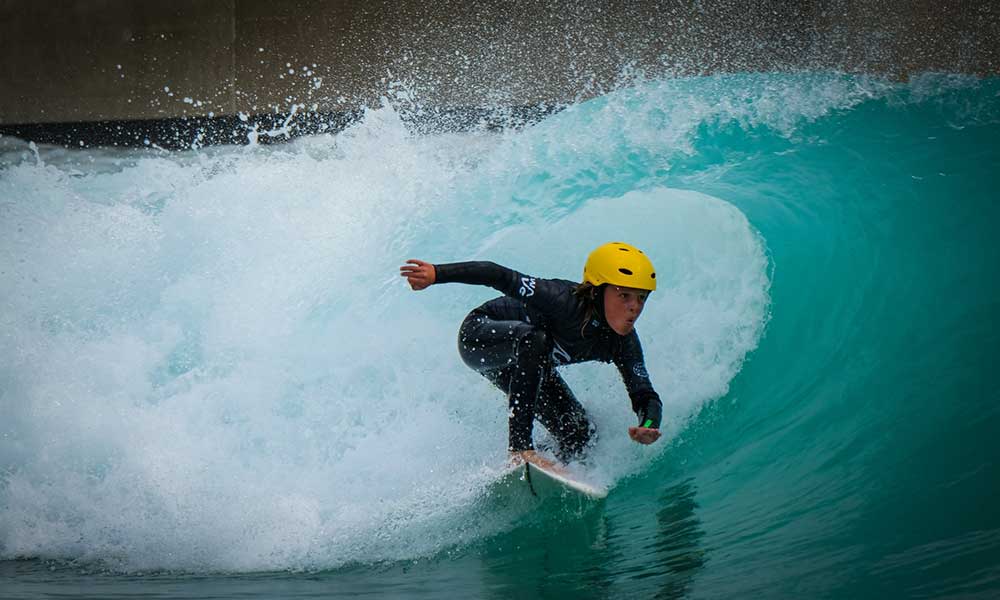Do you need a surf helmet, when should you wear it, and what are the best surf helmets on the market right now?
These are just a few of the questions that we’ll address in this article as we cover everything that you need to know about surfing helmets.
What Is a Surf Helmet?
Surfing helmets are designed to protect you while you surf.
They are lightweight and comfortable and a good helmet will provide optimal protection without impacting your freedom in the water.
Surfing helmets aren’t just for surfing, either.
You can wear them for other watersports, including wakeboarding.
Tom Carroll Talks About Then Benefits Of Wearing A Helmet Surfing
Why do You Need a Surf Helmet?
The idea of wearing a helmet to surf might seem a little preposterous.
After all, the risk of head injuries is pretty low, right?
In actual fact, many surfing-related deaths are the result of head injuries.
Surfers hit their heads on rocks or surfboards, lose consciousness, and succumb to the waves.
It’s rare, but it happens, and if a low-cost surfing helmet can prevent it and save your life, why not buy one?
When Should You Wear a Surf Helmet?
You’re probably wondering, “If wearing a helmet is so important, why do I never see them?” The truth is that some people ignore the risks and refuse to wear a helmet.
They take their chances and that’s their prerogative.
Furthermore, wearing a helmet is more important in rocky breaks and shallow reef breaks where the risk of head collisions are higher.
But even if you’re riding on relatively calm waters, you still have a dangerous and fast-moving hunk of fiberglass attached to your ankle, so you can wear a helmet in all conditions.
What To Look Out For When Buying a Surf Helmet
When shopping for surf helmets, there are a few things that you need to keep in mind:
The Helmet Style
There are three types of surf helmet available.
- Full-face Helmets: Covers the head and face to offer you complete protection. However, they may leave you feeling restricted and are not as comfortable as some other surf helmet options.
- Full-Cut Helmets: Covers the head and ears, offering warmth as well as protection. They may be a little restrictive but have more freedom compared to the full-face surf helmets.
- Half-cut Helmets: Covers the head, with the exception of your face and ears. They are lighter and will give you more freedom.
Water Drainage
A good surf helmet should not hold water and should drain efficiently.
After all, we’re not talking about bike and skateboard helmets here—a surf helmet is going to be exposed to water and must deal with it.
Materials
This is more of a personal consideration, but it’s an important one, nonetheless.
Different parts of surf helmets are made from different materials to serve their respective purpose.
The outer part must consist of a strong material to guarantee protection while the inner parts should be well padded to provide comfort and shock absorption.
Comfort, Fit, and Weight
No one wants a heavy, uncomfortable, and loosely-fitting helmet.
A loose surf helmet may slip and obscure the vision or get in the way.
It may even fall off, and if your head can move around it means that your brain isn’t fully protected.
It may require some physical testing to strike the right balance between comfort, fit, and weight.
Price
Don’t assume that the most expensive option is the best one, and don’t just choose the cheapest one in the hope that it will be just as effective.
It’s about value over price; quality over marketing.
Visor Options
Visors come in different designs.
You should check for one that gives you a wide-angle view. It should not restrict your vision.
Some brands will also provide detachable visors and the quality of these can vary considerably.
Ear Protectors
Don’t forget to check the quality of the ear protectors.
Ear protectors should comfortably cover your ears without fitting too tight.
Many surf helmets use removable ear guards to provide the best of both worlds.
Neoprene VS EVA Headband
These two materials are responsible for your comfort.
But most importantly, they are the chief shock absorbers during an impact.
Both of them are quality materials for padding but you’ll have to make sure the construction and thickness are up to scratch.
Surf Helmet FAQs
How Do You Choose The Right Size Of Surf Helmet For an Optimal Fit?
The right size is one that fits snugly.
It should not be loose when you turn your head.
You will know if it’s the right size when it fits snugly without even buckling the chin strap.
Are Helmets Safe To Surf With?
Yes, all surf helmets in the market have been tested and proven fit for the job.
But their security is dependent on proper use.
Will The Helmet Visor Shatter While Surfing?
No. A helmet visor in good working condition shouldn’t shatter while surfing.
How Much Can A Helmet Really Protect Me?
The level of protection provided by a helmet is dependent on several factors.
The type of helmet (which areas does it protect?), the intensity of the impact, point of impact, and whether or not you were wearing it the right way will all play a role.
Do They Weigh A Lot And Get Annoying When Surfing?
All helmets have been designed to be as lightweight as possible.
Ventilation and drainage have been designed to make sure they don’t retain water and become heavy.
How Do I Take Proper Care Of It?
Each brand will include its own care instructions, but the most important thing is to make sure you rinse your helmet in fresh water and dry it after each surf session.







